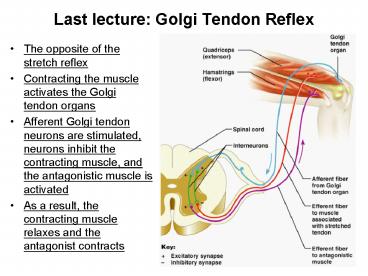Last lecture: Golgi Tendon Reflex PowerPoint PPT Presentation
1 / 18
Title: Last lecture: Golgi Tendon Reflex
1
Last lecture Golgi Tendon Reflex
- The opposite of the stretch reflex
- Contracting the muscle activates the Golgi tendon
organs - Afferent Golgi tendon neurons are stimulated,
neurons inhibit the contracting muscle, and the
antagonistic muscle is activated - As a result, the contracting muscle relaxes and
the antagonist contracts
2
14
- The Autonomic Nervous System
3
Autonomic Nervous System (ANS)
- The ANS consists of motor neurons that
- Innervate smooth and cardiac muscle and glands
- Make adjustments to ensure optimal support for
body activities - Operate via subconscious control
- Have viscera as most of their effectors
ANS Versus Somatic Nervous System (SNS)
- The ANS differs from the SNS in the following
three areas - Effectors
- Efferent pathways
- Target organ responses
4
Effectors
- The effectors of the SNS are skeletal muscles
- The effectors of the ANS are cardiac muscle,
smooth muscle, and glands
Efferent Pathways
- Heavily myelinated axons of the somatic motor
neurons extend from the CNS to the effector - Axons of the ANS are a two-neuron chain
- The preganglionic (first) neuron has a lightly
myelinated axon - The ganglionic (second) neuron extends to an
effector organ
5
Neurotransmitter Effects
- All somatic motor neurons release Acetylcholine
(ACh), which has an excitatory effect - In the ANS
- Preganglionic fibers release ACh
- Postganglionic fibers release norepinephrine or
ACh and the effect is either stimulatory or
inhibitory - ANS effect on the target organ is dependent upon
the neurotransmitter released and the receptor
type of the effector
6
Comparison of Somatic / Autonomic Systems
7
Divisions of the ANS
- The two divisions of the ANS are the sympathetic
and parasympathetic - The sympathetic mobilizes the body during extreme
situations - The parasympathetic performs maintenance
activities and conserves body energy - The two divisions counterbalance each others
activity
8
Role of the Parasympathetic Division
- Concerned with keeping body energy use low
- Involves the D activities digestion,
defecation, and diuresis - Its activity is illustrated in a person who
relaxes after a meal - Blood pressure, heart rate, and respiratory rates
are low - Gastrointestinal tract activity is high
- The skin is warm and the pupils are constricted
9
Role of the Sympathetic Division
- The sympathetic division is the fight-or-flight
system - Involves E activities exercise, excitement,
emergency, and embarrassment - Promotes adjustments during exercise blood flow
to organs is reduced, flow to muscles is
increased - Its activity is illustrated by a person who is
threatened - Heart rate increases, and breathing is rapid and
deep - The skin is cold and sweaty, and the pupils dilate
10
Anatomy of ANS
11
Parasympathetic Division Outflow
12
Sympathetic Outflow
- Arises from spinal cord segments T1 through L2
- Sympathetic neurons produce the lateral horns of
the spinal cord - Preganglionic fibers pass through the white rami
communicantes and synapse in the chain
(paravertebral) ganglia - Fibers from T5-L2 form splanchnic nerves and
synapse with collateral ganglia - Postganglionic fibers innervate the numerous
organs of the body
13
Sympathetic Outflow
14
Sympathetic Trunks and Pathways
- The paravertebral ganglia form part of the
sympathetic trunk or chain - Typically there are 23 ganglia 3 cervical, 11
thoracic, 4 lumbar, 4 sacral, and 1 coccygeal
15
Pathways to the Head
- Preganglionic fibers emerge from T1-T4 and
synapse in the superior cervical ganglion - These fibers
- Serve the skin and blood vessels of the head
- Stimulate dilator muscles of the iris
- Inhibit nasal and salivary glands
Pathways to the Thorax
- Preganglionic fibers emerge from T1-T6
- Postganglionic fibers emerge from the middle and
inferior cervical ganglia and enter nerves C4-C8 - These fibers innervate the heart via the cardiac
plexus, as well as innervating the thyroid and
the skin - Postganglionic fibers directly serve the heart,
aorta, lungs, and esophagus
16
Pathways with Synapses in Collateral Ganglia
- These fibers (T5-L2) leave the sympathetic chain
without synapsing - They form thoracic, lumbar, and sacral splanchnic
nerves - Their ganglia include the celiac, the superior
and inferior mesenterics, and the hypogastric
17
Pathways to the Abdomen
- Sympathetic nerves innervating the abdomen have
preganglionic fibers from T5-L2 - They travel through the thoracic splanchnic
nerves and synapse at the celiac and superior
mesenteric ganglia - Postganglionic fibers serve the stomach,
intestines, liver, spleen, and kidneys
18
Pathways to the Pelvis
- Preganglionic fibers originate from T10-L2
- Most travel via the lumbar and sacral splanchnic
nerves to the inferior mesenteric and hypogastric
ganglia - Postganglionic fibers serve the distal half of
the large intestine, the urinary bladder, and the
reproductive organs

